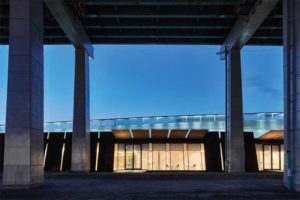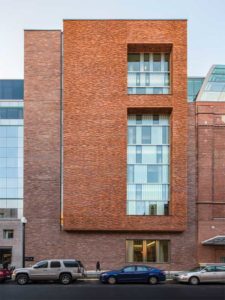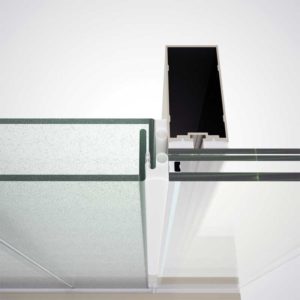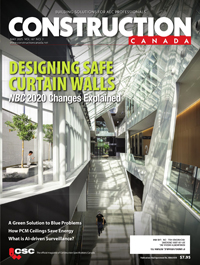Building green with channel glass

Shining a light
The channel glass at Fort York’s Visitor Centre features a light-diffusing surface texture. At night, when the façade is illuminated by lighting fixtures attached to the back of the glass system, the texture produces a gentle glow, a subtle “ghostly” esthetic.
According to Kearns, the inspiration for the channel glass façade came through the idea of a projection-type surface to showcase images of the battlefield. When this idea became technically difficult to achieve within the budget the project team looked for an alternate solution. Channel glass was finally employed as it could be back-lit to create a spectral, ghostly feeling at night.
The choice of the luminous back-lit channel glass façade led to project savings of more than $1 million. The estimate for the total upgrade was budgeted at $25 million.
Serving as the fort’s new front door, the visitor centre contains artifacts highlighting the history of the city, as well as educational and research facilities. The linear flow of the space, combined with the chronological organization of its exhibits, provides a kind of “time tunnel” experience. At the end of the tunnel, visitors emerge onto the fort grounds through two expansive channel glass walls.
“As this part of the building evolved from being a ghost screen into a more substantial element, the choice of glass still has that transparency and almost ghostly quality, especially when illuminated at night. It is quite beautiful,” said Kearns.

Photo © Alex Fradkin
Channel glass in the United States
Lighting was also a main design focus at the new Museum of the Bible in Washington, D.C. Opened in 2017, the museum showcases rare and fascinating artifacts spanning 3500 years of history, offering visitors an experience of the Bible and its impact on the world. The museum’s lobby arcade is clad in low-iron channel glass in a translucent white ceramic frit, spanning more than 7 m (22 ft) in height.
The main design objective was to reflect light throughout the lobby, top to bottom. Light radiating from the 43-m (140-ft) long light-emitting diode (LED) ceiling the length of the lobby bounces off the polished channel glass surfaces. According to the project’s architects, the effect magnifies the colour and light from the images moving and changing on LED displays throughout the museum’s arcade, thereby transforming the character of the space by creating an immersive experience.
The exterior of the building features textured channel glass. This light-diffusing glass creates a contrast with adjacent clear insulating glass units (IGUs). The design team was able to successfully integrate the two glass types with the glass manufacturer’s assistance by implementing minimal tie-ins (Figure 2).
“The translucent channel glass bridges the old building and the new museum,” said David Greenbaum, FAIA,

Image © Said Elieh, Bendheim
SmithGroup lead designer. “The combination of clear and translucent glass is symbolic of the search for clarity and countering moral ambiguity, inherent to the study of the Bible. When compared to the clear windows, the channel glass implies the human struggle to find an ethical and moral path in our daily lives.”
Environmental benefits of channel glass
Channel glass is a naturally sustainable and recyclable material. It is made of abundant raw ingredients such as sand, soda ash, and limestone. Some channel glass manufacturers have created environmental product declarations (EPDs). The internationally standardized evaluation provides full disclosure of the glass’ environmental footprint. It provides natural daylight, energizing interiors, and reducing the need for artificial lighting. Channel glass also controls acoustics and improves the energy efficiency of the building, aiding or assisting occupant wellness. Additionally, channel glass reduces glare and provides noise control, occupant privacy, and visible light transmittance (VLT). Channel glass can achieve VLT of up to 77 per cent, providing diffused daylight, which can be more desirable than clear views. The self-supporting glass with insulation also reaches a high thermal performance target with a U-value 0.19. Unlike a plain 114-mm (4.5-in.) batt-insulated stud wall impervious to light, channel glass can reach a sound-reduction rating of sound transmission class (STC) 43 and outdoor-indoor transmission class (OITC) of 36.





